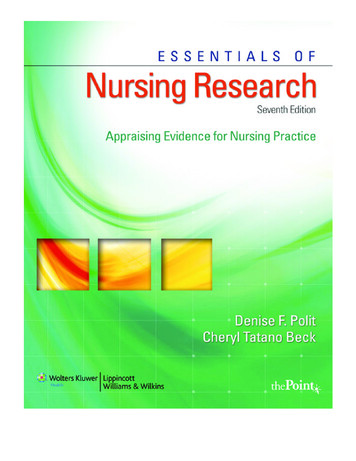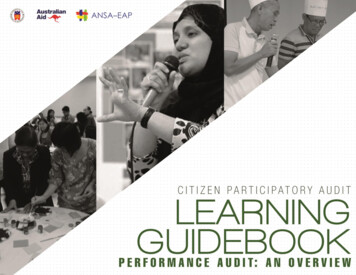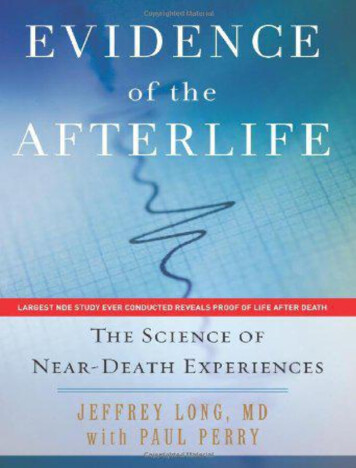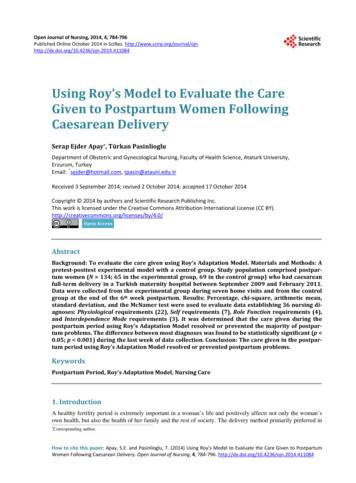
Transcription
LWBK131-3938G-FM.[i-xiv]qxd 11/1/08 12:41 PM Page i Aptara (PPG-Quark)seventh editionEssentials ofNursing ResearchAppraising Evidencefor Nursing PracticeD E N I S E F. P O L I T, PhDPresident, Humanalysis, Inc., Saratoga Springs, New Yorkand Adjunct Professor, Griffith University School of Nursing,Gold Coast, Australia(www.denisepolit.com)C H E R Y L TATA N O B E C K , DNSc, CNM, FAANDistinguished Professor, School of Nursing,University of ConnecticutStorrs, Connecticut
LWBK131-3938G-FM.[i-xiv]qxd 11/1/08 12:41 PM Page ii Aptara (PPG-Quark)Acquisitions Editor: Hilarie SurrenaManaging Editor: Helen KogutDirector of Nursing Production: Helen EwanSenior Managing Editor / Production: Erika KorsProduction Editor: Mary KinsellaArt Director, Design: Joan WendtArt Director, Illustration: Brett McNaughtonManufacturing Coordinator: Karin DuffieldProduction Services / Compositor: AptaraSeventh EditionCopyright 2010 Wolters Kluwer Health Lippincott Williams & Wilkins.Copyright 2006, 2001 by Lippincott Williams & Wilkins. Copyright 1997 by Lippincott–Raven Publishers. Copyright 1993, 1989, 1985 by J. B. Lippincott Company. All rights reserved. This book is protected by copyright. No part of this book may be reproduced or transmitted in any form or by any means,including as photocopies or scanned-in or other electronic copies, or utilized by any information storageand retrieval system without written permission from the copyright owner, except for brief quotationsembodied in critical articles and reviews. Materials appearing in this book prepared by individuals as partof their official duties as U.S. government employees are not covered by the above-mentioned copyright.To request permission, please contact Lippincott Williams & Wilkins at 530 Walnut Street, PhiladelphiaPA 19106, via email at permissions@lww.com or via website at lww.com (products and services).987654321Printed in ChinaLibrary of Congress Cataloging-in-Publication DataPolit, Denise F.Essentials of nursing research : appraising evidence for nursing practice / Denise F. Polit, CherylTatano Beck. — 7th ed.p. ; cm.Includes bibliographical references and index.ISBN-13: 978-0-7817-8153-4 (alk. paper)ISBN-10: 0-7817-8153-1 (alk. paper)1. Nursing—Research. I. Beck, Cheryl Tatano. II. Title.[DNLM: 1. Nursing Research. WY 20.5 P769eg 2008]RT81.5.P63 2008610.73072—dc222008047112Care has been taken to confirm the accuracy of the information presented and to describe generally accepted practices. However, the authors, editors, and publisher are not responsible for errors oromissions or for any consequences from application of the information in this book and make no warranty, expressed or implied, with respect to the currency, completeness, or accuracy of the contents of thepublication. Application of this information in a particular situation remains the professional responsibility of the practitioner; the clinical treatments described and recommended may not be consideredabsolute and universal recommendations.The authors, editors, and publisher have exerted every effort to ensure that drug selection anddosage set forth in this text are in accordance with the current recommendations and practice at the timeof publication. However, in view of ongoing research, changes in government regulations, and the constantflow of information relating to drug therapy and drug reactions, the reader is urged to check the packageinsert for each drug for any change in indications and dosage and for added warnings and precautions. Thisis particularly important when the recommended agent is a new or infrequently employed drug.Some drugs and medical devices presented in this publication have Food and Drug Administration (FDA) clearance for limited use in restricted research settings. It is the responsibility of the health careprovider to ascertain the FDA status of each drug or device planned for use in his or her clinical practice.LWW.COM
LWBK131-3938G-FM.[i-xiv]qxd 11/1/08 12:41 PM Page iii Aptara (PPG-Quark)To Our Students From Around the WorldWhose interests, passions, and curiosity have fueled our dedication to good teachingand to high-quality research
LWBK131-3938G-FM.[i-xiv]qxd 11/1/08 12:41 PM Page iv Aptara (PPG-Quark)R E V I E W E R SKathleen Barta, EdD, RNAssociate ProfessorUniversity of ArkansasFayetteville, ArkansasMarilyn Handley, RN, PhDAssociate ProfessorUniversity of AlabamaTuscaloosa, AlabamaMary Bennett, RN, MS, DNSc, FNPAssistant Dean; Associate ProfessorIndiana State UniversityTerre Haute, IndianaGrace E. Hardie, RN, PhDAssistant Professor; Assistant Clinical Professor;Collaborative ResearcherSan Francisco State University;University of San FranciscoSan Francisco, CaliforniaCarolyn Blue, RN, PhD, CHESProfessorUniversity of North CarolinaGreensboro, North CarolinaDiane Breckenridge, PhD, RNAssociate ProfessorLa Salle UniversityPhiladelphia, PennsylvaniaSusan Hendricks, PhDIndiana UniversityKokomo, IndianaElizabeth HillDuke UniversityDurham, North CarolinaBecky Christian, PhD, RNAssociate Professor; Division ChairUniversity of UtahSalt Lake City, UtahAnn Hilton, RN, PhDProfessor and Coordinator of MSN ProgramUniversity of British ColumbiaVancouver, British ColumbiaLinda Cook, RN, BCAssociate ProfessorBloomsburg University of PennsylvaniaBloomsburg, PennsylvaniaBarbara J. Hoerst, RN, PhDAssistant ProfessorLa Salle UniversityPhiladelphia, PennsylvaniaBernadette Curry, PhDMolloy CollegeRockville Centre, New YorkKaryn Holm, PhD, RN, FAANProfessorDePaul UniversityChicago, IllinoisBarbara Davis, PhD, RNProfessorUniversity of Southern IndianaEvansville, IndianaDebra Horoho, MSNIndiana UniversityKokomo, IndianaVelma Edmonds, DNS, MSN, BSN, RNAssistant ProfessorUniversity of TexasEl Paso, TexasAnn Jacobson, PhD, RNAssociate ProfessorKent State UniversityKent, OhioKay Foland, PhD, APRN, BC, CNPAssociate ProfessorSouth Dakota State UniversityRapid City, South DakotaPeggy Leapley, PhD, RN, FNP, CNS, APRN, BCProfessor and Chair of NursingCalifornia State UniversityBakersfield, CaliforniaSharon George, PhDUniversity of AlabamaHuntsville, AlabamaGayle Lee, PhD, FNP-C, CCRNNursing FacultyBrigham Young University, IdahoRexburg, Idahoiv
LWBK131-3938G-FM.[i-xiv]qxd 11/3/08 10:01 PM Page v Aptara Inc.Margaret Louis, PhDUniversity of NevadaLas Vegas, NevadaNelda Martinez, PhD, RNAssociate Professor; Senior FellowUniversity of Texas, El Paso; Hispanic Health DisparitiesResearch CenterEl Paso, TexasCarrie McCoy, PhD, MSPH, RN, CENProfessor; Director of ABSN ProgramNorthern Kentucky UniversityHighland Heights, KentuckyMarylou K. McHugh, RN, EdDAdjunct FacultyDrexel University; Temple UniversityPhiladelphia, PennsylvaniaNancy Menzel, PhD, APRN-BC, COHN-S, CNEAssociate ProfessorUniversity of Nevada, Las VegasLas Vegas, NevadaRuby MorrisonUniversity of AlabamaTuscaloosa, AlabamaDonna Musser, PhD, RNAssistant ProfessorUniversity of Central ArkansasConway, ArkansasSarah Newton, PhD, RNAssociate ProfessorOakland UniversityRochester, MichiganPriscilla C. O’Connor, PhD, APRN, BCLecturerTemple UniversityPhiladelphia, PennsylvaniaNicole Ouellet, PhD, RNProfessorUniversité du Québec à RimouskiRimouski, QuebecElizabeth Petit De Mange, RN, PhDAssistant ProfessorDrexel UniversityPhiladelphia, PennsylvaniaPammla Petrucka, RN, BSc, BScN, MN, PhDAssociate ProfessorUniversity of SaskatchewanRegina, SaskatchewanJanice Polizzi, MSN, RNAssociate ProfessorFlorida Hospital CollegeOrlando, FloridaPatsy RileyTroy UniversityTroy, AlabamaDenise Robinson, PhD, RN, FNPInterim Chair and Regents ProfessorNorthern Kentucky UniversityHighland Heights, KentuckyNancy SchlapmanIndiana UniversityKokomo, IndianaJoanne Serembus, EdD, RN, CCRN, CNEClinical Associate ProfessorDrexel UniversityPhiladelphia, PennsylvaniaSandra L. Siedlecki, RN, CNS, PhDSenior Nurse ResearcherCleveland Clinic FoundationCleveland, OhioMatthew Sorenson, PhD, RNAssistant ProfessorDePaul UniversityChicago, IllinoisValmi Sousa, PhDUniversity of North CarolinaCharlotte, North CarolinaAmy Spurlock, PhD, RNAssociate ProfessorTroy State UniversityTroy, AlabamaThomas Stenvig, RN, PhD, MPH, CNAAAssociate ProfessorSouth Dakota State UniversityBrookings, South Dakotav
LWBK131-3938G-FM.[i-xiv]qxd 11/1/08 12:41 PM Page vi Aptara (PPG-Quark)Marliyn Stoner, RN, PhDAssociate ProfessorCalifornia State UniversitySan Bernardino, CaliforniaHelene Sylvain, PhDUniversité du Québec à RimouskiRimouski, QuebecJane TarnowDePaul UniversityChicago, IllinoisBecky ThielShawnee State UniversityPortsmouth, OhioMolly Walker, PhD, RN, CNSAssociate ProfessorAngelo State UniversitySan Angelo, TexasKaren Ward, PhDMiddle Tennessee State UniversityMurfreesboro, TennesseeGail Washington, DNS, RNAssistant ProfessorCalifornia State UniversityLos Angeles, CaliforniaJoan Wasserman, PhD, MBA, RNAssistant ProfessorUniversity of Texas, HoustonHouston, TexasviLatricia Weed, PhDTroy State UniversityTroy, AlabamaKatherine Willock, PhD, APRN, BCAssociate Professor and Director of Graduate ProgramsIndiana University-Purdue UniversityFort Wayne, IndianaEvelyn Wills, BSN, MSN, PhDProfessorUniversity of LouisianaLafayette, LouisianaMary Woo, DNSc, RNProfessorUniversity of CaliforniaLos Angeles, CaliforniaGeri L. Wood, PhD, RN, FAANAssociate ProfessorUniversity of Texas Health Science CenterHouston, TexasPatti Rager Zuzelo, EdD, APRN, BC, CNSAssociate Professor & CNS Track Coordinator;Associate Director of Nursing for ResearchLa Salle University; Albert Einstein Healthcare NetworkPhiladelphia, Pennsylvania
LWBK131-3938G-FM.[i-xiv]qxd 11/1/08 12:41 PM Page vii Aptara (PPG-Quark)PREF ACEThis book marks the seventh time we have worked on this textbook, which isdesigned to teach students how to read research reports and critique the methodsused in nursing studies. It is perhaps difficult to imagine that writing a seventh edition of a textbook on research methods could be fun—but that is exactly the rightword to describe our experience in working on this new edition. We have mademany changes to the content and organization of this textbook, and the revisionskept our enthusiasm and energy for this project at a very high level. We are confident that we have introduced numerous improvements—but at the same time, wehave retained many features that have made this book a classic throughout theworld. We think that this edition will make it easier and more satisfying for nursesto pursue a professional pathway that incorporates thoughtful appraisals of evidence.NEW TO THIS EDITIONUp-front, Consistent Emphasis on Evidence-Based PracticeTo an even greater extent than in the past, we emphasize in this edition that research isa crucial enterprise for building an evidence base for nursing practice. We have giventhe topic of evidence-based practice (EBP) greater prominence by making the chapteron EBP the second chapter of the book (previously the last chapter), and by expandingits content. We emphasize throughout that high-quality evidence is a product ofresearchers’ decisions in designing and executing a study. Every chapter offers guidanceon how to appraise research evidence for its utility in informing nurses’ clinical decisions. We have also added a new chapter on how to read, interpret, and critique systematic reviews, which are considered by many to be a cornerstone of EBP. The StudyGuide that supplements this textbook includes a full report of an EBP project. Theincreased focus on EBP prompted us to modify the book’s title to emphasize the important link between research and evidence.New Material Relating to Medical Research MethodologyNurse researchers have tended to use methods and jargon that originated in thesocial sciences, but the push for EBP in medicine has led to methodologic innovations that are relevant to all healthcare research. Moreover, nurses can profit fromfamiliarity with medical research terms and approaches so they can comfortablyread articles in a broad range of health care journals. This edition offers a more balanced presentation of medical and social science methods and nomenclature.Improved Content on Qualitative MethodsIn every new edition we have expanded content on qualitative research methods,and this edition is no exception. We are especially pleased to include a new chaptervii
LWBK131-3938G-FM.[i-xiv]qxd 11/1/08 12:41 PM Page viii Aptara (PPG-Quark)viiiPREFACEon the issue of quality and trustworthiness in qualitative inquiry, Chapter 18. We believethat the content and breadth of this important chapter is unparalleled in other general textbooks on research methods for nurses.Greater Assistance With InterpretationMany books on research methods describe the techniques used to generate evidence, butthey typically offer little or no guidance on interpreting research results. We have madeefforts to address this deficiency by offering an interpretive framework for both quantitative (Chapter 16) and qualitative (Chapter 18) research.Additional Support for Research Appraisals—The ToolkitEach chapter of the book includes questions to aid students in reading and appraisingresearch journal articles. In this edition, these critiquing guidelines are also available onthe accompanying Student CD-ROM and. With electronic files of these resources,students can download the guidelines, adapt them as needed, and then enter theiranswers to the questions directly, without having to photocopy pages from the book.Many faculty have told us that the general critiquing guidelines (which we have put in anearlier chapter than in previous editions) are useful as handouts, and now they are morereadily accessible.ORGANIZATION OF THE TEXTThe content of this edition is organized into five main parts.* Part I—Overview of Nursing Research and Its Role in Evidence-Based Practiceintroduces fundamental concepts in nursing research. Chapter 1 summarizes the history and future of nursing research, discusses the philosophical underpinnings of qualitative research versus quantitative research, and describes major purposes of nursingresearch. Chapter 2 offers guidance on using research to build an EBP. Chapter 3 introduces readers to key research terms, and presents an overview of steps in the researchprocess for both qualitative and quantitative studies. Chapter 4 focuses on researchreports, explaining what they are and how to read them. Chapter 5 discusses ethics innursing studies.* Part II—Preliminary Steps in the Appraisal of Evidence further sets the stage forlearning about the research process by considering aspects of a study’s conceptualization. Chapter 6 focuses on the development of research questions and the formulationof research hypotheses. Chapter 7 discusses how to prepare and critique literaturereviews. Chapter 8 presents information about theoretical and conceptual frameworks.* Part III—Designs for Nursing Research presents material on the design of qualitativeand quantitative nursing studies. Chapter 9 describes some fundamental design principles and discusses many specific aspects of quantitative research design. Chapter 10
LWBK131-3938G-FM.[i-xiv]qxd 11/1/08 12:41 PM Page ix Aptara (PPG-Quark)PREFACEixaddresses the various research traditions that have contributed to the growth of naturalistic inquiry and qualitative research. Chapter 11 provides an introduction to somespecific types of research (e.g., evaluations, surveys, secondary analyses), and alsodescribes mixed method studies that integrate qualitative and quantitative components.Chapter 12 introduces designs for sampling study participants.* Part IV—Data Collection concerns the gathering of data to address research questions. Chapter 13 discusses a range of data collection options for nurse researchers,including both qualitative and quantitative approaches. Chapter 14 describes theconcept of measurement and criteria for assessing data quality in quantitativestudies.* Part V—Data Analysis and Interpretation discusses analytic methods for qualitativeand quantitative research. Chapter 15 reviews methods of quantitative analysis. Thechapter assumes no prior instruction in statistics and focuses primarily on helping readers to understand why statistics are needed, what tests might be appropriate in a givensituation, and what statistical information in a research report means. Chapter 16 discusses ways of appraising rigor in quantitative studies, and approaches to interpretingstatistical results. Chapter 17 presents a discussion of qualitative analysis, with anemphasis on ethnographies, phenomenologic studies, and grounded theory studies.Chapter 18 elaborates on criteria for appraising integrity and quality in qualitative studies. Finally, Chapter 19 describes systematic reviews, including how to understand andappraise both meta-analyses and metasyntheses.KEY FEATURESThis edition, like its predecessors, is focused on the art—and science—of research critiques.It offers guidance to students who are learning to appraise research reports and useresearch findings in practice. Among the basic principles that helped to shape this and earlier editions of this book are (1) an assumption that competence in doing and appraisingresearch are critical to the nursing profession; (2) a conviction that research inquiry isintellectually and professionally rewarding to nurses; and (3) an unswerving belief thatlearning about research methods need be neither intimidating nor dull. Consistent withthese principles, we have tried to present research fundamentals in a way that both facilitates understanding and arouses curiosity and interest.General FeaturesWe have retained many of the key features that were successfully used in previous editionsto assist consumers of nursing research:* Clear, “User-Friendly” Style. Our writing style is designed to be easily digestibleand nonintimidating. Concepts are introduced carefully and systematically, difficultideas are presented clearly, and readers are assumed to have no prior knowledge of technical terms.
LWBK131-3938G-FM.[i-xiv]qxd 11/1/08 12:41 PM Page x Aptara (PPG-Quark)xPREFACE* Critiquing Guidelines. Each chapter includes guidelines for conducting a critique ofvarious aspects of a research report. The guidelines sections provide a list of questionsthat walk students through a study, drawing attention to aspects of the study that areamenable to appraisal by research consumers. Electronic versions of the guidelines areavailable on the accompanying student CD-ROM and thePoint.* Research Examples. Each chapter concludes with one or two actual research examplesdesigned to highlight critical points made in the chapter and to sharpen the reader’s critical thinking skills. In addition, many research examples are used to illustrate key pointsin the text and to stimulate students’ thinking about areas of research inquiry. We havechosen many international examples to communicate to students that nursing researchis growing in importance worldwide.* Tips for Consumers. The textbook is filled with practical guidance and “tips” on howto translate the abstract notions of research methods into more concrete applications.In these tips, we have paid special attention to helping students read research reports,which are often daunting to those without specialized research training.* Graphics. Colorful graphics, in the form of supportive tables, figures, and examples,reinforce the text and offer visual stimulation.Features for Student LearningWe have used many features to enhance and reinforce learning—and, especially, to facilitate the development of critiquing skills. These include the following:* Student Objectives. Learning objectives are identified in the chapter opener to focusstudents’ attention on critical content.* Key Terms. New terms are defined in context (and bolded) when used for the first timein the text. Each chapter concludes with a list of new terms, and we have made the listless daunting by including only key new terms. A glossary at the end of the book providesadditional support for those needing to look up the meaning of a methodologic term.* Bulleted Summary Points. A succinct list of summary points that focus on salientchapter content is included at the end of each chapter.* Full-Length Research Articles. In this edition, the textbook includes four recent fulllength studies—two quantitative and two qualitative—that students can read, analyze,and critique. Two appear in the appendices of the textbook, and two are on the CD-ROMpackaged with the book and thePoint.* Critiquing Supports. Each chapter of the textbook concludes with “Critical ThinkingActivities”—exercises that provide opportunities to practice critiquing. Some exercisesare based on the studies that are included in their entirety in the appendices of the book,while others are based on studies that are summarized at the end of the chapters. Importantly, students can then consult the accompanying CD-ROM and thePoint to find our“answers” (our expert thoughts about each question), so that students can get immediatefeedback about their grasp of material in the chapter. (In some cases, there are alsothoughtful comments by the actual researchers who conducted the studies). This edition
LWBK131-3938G-FM.[i-xiv]qxd 11/1/08 12:41 PM Page xi Aptara (PPG-Quark)PREFACExialso includes full critiques of the two studies on the CD-ROM and thePoint, which students can use as models for a comprehensive research critique. Many more critiquingopportunities are available in the Study Guide, which includes seven studies in theirentirety in the appendices and exercises in each chapter that guide students in reading,understanding, and critiquing these studies.TEACHING-LEARNING PACKAGEEssentials of Nursing Research: Appraising Evidence for Nursing Practice, seventh edition, has an ancillary package designed with both students and instructors in mind.* The Study Guide augments the text and provides students with application exercises foreach text chapter. Critiquing skills are emphasized, but there are also activities to support the learning of fundamental research terms and principles. Seven recent studies—including one report of an EBP project—are included in the appendices, and manychapter exercises are based on these studies. The studies represent a range of researchtypes, including a clinical trial, a survey, an evaluation of an EBP project, a groundedtheory study, a feminist study, a meta-analysis, and a metasynthesis.* Free CD-ROM. The textbook includes a CD-ROM that has many important resources.First, as noted, we provide our answers to the Critical Thinking Activities from the textbook. Critiquing guidelines for each chapter, as well as some other resources, areincluded as a toolkit in electronic files for downloading, adapting, and printing. Next,the CD-ROM provides hundreds of review questions to assist students in self-testing.This review program provides a rationale for both correct and incorrect answers, helping students to identify areas of strength and areas needing further study. Finally, theCD-ROM has lists of relevant and useful websites for each chapter, which can be“clicked” on directly without having to retype the URL and risk a typographical error.All of these resources are also available on thePoint.* The Instructor’s Resource CD-ROM (IRCD) includes a chapter corresponding toevery chapter in the textbook. Each IRCD chapter contains the following: Statement ofIntent, Special Class Projects, Answers to Selected Study Guide Exercises, and TestQuestions and Answers. In the special class projects, we offer opportunities for studentsto develop a quantitative and (or) a qualitative data set. With regard to test questions toevaluate student learning, we offer multiple choice and true/false questions and, importantly, we have added questions specifically designed to test students’ ability to comprehend research reports. In addition, PowerPoint slides summarizing key points in eachchapter are available in a format that permits easy adaptation. All of this content is alsoavailable on thePoint.It is our hope and expectation that the content, style, and organization of this seventh editionof Essentials of Nursing Research will be helpful to those students desiring to become skillfuland thoughtful readers of nursing studies and to those wishing to enhance their clinical performance based on research findings. We also hope that this textbook will help to develop anenthusiasm for the kinds of discoveries and knowledge that research can produce.
LWBK131-3938G-FM.[i-xiv]qxd 11/1/08 12:41 PM Page xii Aptara (PPG-Quark)xiiACKNOWLEDGMENTSDENISE F. POLIT, PhDCHERYL TATANO BECK, DNSc, CNM, FAANACKNOWLEDGMENTSThis seventh edition, like the previous six editions, depended on the contribution of manygenerous people. Many faculty and students who used the text have made invaluable suggestions for its improvement, and to all of you we are very grateful. Suggestions were madeto us both directly in personal interactions (mostly at the University of Connecticut andGriffith University in Australia), and via the wonderful communication tool of email correspondence. In addition to all those who assisted us during the past three decades with theearlier editions, there are some who deserve special mention for this new work.We would like to acknowledge the comments of the reviewers of the previous edition ofEssentials, whose anonymous feedback influenced our revisions. Several of the commentstriggered several important changes, and for this we are indebted.Other individuals made specific contributions. Although it would be impossible to mention all, we note with thanks the nurse researchers who shared their work with us as wedeveloped examples, including work that in some cases was not yet published. Through theInternet, we worked with authors of the reports that appear in the appendices. We sharedwith them our critiques and “answers” to the critiquing exercises to make sure that we hadnot misread or misinterpreted their reports, and they gave generously of their time inreviewing our material. Special thanks to Carol Howell, Marti Rice, Linda Walsh, andMichael McGillion for their help. We also got extraordinary cooperation from the authorsof studies that were summarized at the end of the chapters, and we are grateful to them all.We extend our warm thanks as well to those who helped to turn the manuscript into afinished product. The staff at Lippincott Williams & Wilkins has been of tremendous assistance in the support they have given us over the years. We are indebted to Hilarie Surrena,Helen Kogut, Mary Kinsella, Annette Ferran, Joan Wendt, and all the others behind thescenes for their fine contributions.Finally, we thank our family, our loved ones, and our friends, who provided ongoing support and encouragement throughout this endeavor and who were tolerant when we workedlong into the night, over weekends, and during holidays to get this seventh edition finished.
LWBK131-3938G-FM.[i-xiv]qxd 11/14/08 12:48 AM Page xiii Aptara Inc.C O N T E N T SPART 1:12345Introduction to Nursing Research in an Evidence-Based PracticeEnvironmentEvidence-Based Nursing Practice: FundamentalsKey Concepts and Steps in Qualitative and Quantitative ResearchReading and Critiquing Research ReportsEthics in ResearchPART 2:67813141516171819221258284305DATA COLLECTIONData Collection MethodsMeasurement and Data QualityPART 5:145169194DESIGNS FOR NURSING RESEARCHQuantitative Research DesignQualitative Designs and ApproachesSpecific Types of ResearchSampling PlansPART 4:3336187117PRELIMINARY STEPS IN THE APPRAISAL OF EVIDENCEResearch Problems, Research Questions, and HypothesesLiterature Reviews: Finding and Reviewing Research EvidenceTheoretical and Conceptual FrameworksPART 3:9101112OVERVIEW OF NURSING RESEARCH AND ITS ROLE INEVIDENCE-BASED PRACTICE337369DATA ANALYSIS AND INTERPRETATIONStatistical Analysis of Quantitative DataRigor and Interpretation in Quantitative ResearchAnalysis of Qualitative DataTrustworthiness and Integrity in Qualitative ResearchSystematic Reviews: Meta-Analysis and Metasynthesis391440462489514Methodologic and Theoretical References541Glossary547Glossary of Selected Statistical Symbols572xiii
LWBK131-3938G-FM.[i-xiv]qxd 11/1/08 12:41 PM Page xiv Aptara (PPG-Quark)xivCONTENTSAPPENDICES: RESEARCH REPORTSABThe Relationships Among Anxiety, Anger, and Blood Pressure in ChildrenThe Anniversary of Birth Trauma574581Index591
LWBK131-3938G-C01 01-32.qxd 1/11/08 9:50 am Page 2 Aptara (PPG-Quark)
LWBK131-3938G-C01 01-32.qxd 1/11/08 9:50 am Page 1 Aptara (PPG-Quark)part1Overview ofNursingResearchand Its Role inEvidence-BasedPractice
LWBK131-3938G-C01 01-32.qxd 1/11/08 9:50 am Page 3 Aptara (PPG-Quark)c h a p t e r1Introduction toNursing Research in anEvidence-Based PracticeEnvironmentNURSING RESEARCH IN PERSPECTIVEPARADIGMS FOR NURSING RESEARCHWhat Is Nursing Research?The Importance of Research to Evidence-Based NursingPracticeRoles of Nurses in ResearchThe Positivist ParadigmThe Naturalistic ParadigmParadigms and Methods: Quantitative and QualitativeResearchMultiple Paradigms and Nursing ResearchNURSING RESEARCH: PAST, PRESENT, AND FUTUREThe Early Years: From Nightingale to the 1970sNursing Research Since 1980Directions for Nursing Research in the New MillenniumPURPOSES OF NURSING RESEARCHSOURCES OF EVIDENCE FOR NURSING PRACTICEASSISTANCE FOR CONSUMERS OF NURSING RESEARCHTradition and AuthorityClinical Experience, Trial and Error, and IntuitionLogical ReasoningAssembled InformationDisciplined ResearchResearch to Achieve Various Levels of ExplanationResearch Purposes Linked to EBPRESEARCH EXAMPLES AND CRITICAL THINKINGACTIVITIESCHAPTER REVIEWKey New TermsSummary PointsSTUDIES CITED IN CHAPTER 1STUDENT OBJECTIVESOn completing this chapter, you will be able to:* Describe why research is important in the nursing profession and discuss the need forevidence-based practice* Describe historic trends and future directions in nursing research* Describe alter
The Study Guide that supplements this textbook includes a full report of an EBP project. The increased focus on EBP prompted us to modify the book’s title to emphasize the impor- . Many books on research methods describe the techniques used to generate evidence, but they typically offer l






![project2 Encase.pptx [Read-Only]](/img/12/project2-encase.jpg)



